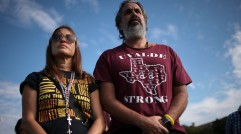Space Shuttle Program Returning to U.S.
A space shuttle program is returning to America, thanks to the privately-held Sierra Nevada Corporation, which plans to launch a mini-version of the original shuttle design in 2016.
Named the Dream Chaser, the winged vehicle is scheduled to lift off from Florida's Kennedy Space Center Nov. 1 of that year, on top of an Atlas V rocket.
The debut voyage of the Dream Chaser -- a re-useable, lifting-body type vehicle -- will be unmanned, autonomous flight, though the craft will be built to carry a crew of seven into low-earth orbit.
The shuttle is on track to spend about a day in orbit before returning to a landing strip on the West Coast. Then, if all goes well, the company will launch its first manned mission the following year, in 2017.
Plans for the Dream Chaser were unveiled during a joint media conference that included representatives from SNC, the National Aeronautics and Space Administration and United Launch Alliance, operator of the Atlas rocket.
With a length of 29.5 feet and mass of 25,000 pounds, the Dream Chaser is one of the three commercial human transport systems currently under development with financial and technical backing from NASA.
The other two delivery vehicles, Boeing's CST-100 and SpaceX's Dragon, follow more traditional capsule designs.
NASA has suggested that, starting later this year, it may ultimately concentrate its resources on two, maybe only one, of the systems in the effort to restore America's capability to launch its own astronauts into space -- which was lost when the original shuttles were retired in 2011.
Currently, each NASA astronaut flies to the International Space Station aboard a Russian Soyuz capsule, which costs about $60 million per seat.
It's expected passage on any of the vehicles being engineered by the three United States-based companies will be notable less expensive for NASA astronauts.
Development of the Dream Chaser will continue, says SNC, even if it doesn't receive NASA's next round of funding.
"We are building the vehicle to be launched, and we have made a commitment to the launch," said Mark Sirangelo, corporate vice-president for SNC's Space Systems.
The Dream Chaser's maiden trip is a direct relationship between Sierra Nevada and ULA, with SNC covering all the costs, apart from the NASA program, he said.
Two weeks ago, SNC announced it had forged relationships with the European and German space agencies, which may mean components and materials on future vehicles could come from across the ocean.
Subscribe to Latin Post!
Sign up for our free newsletter for the Latest coverage!














